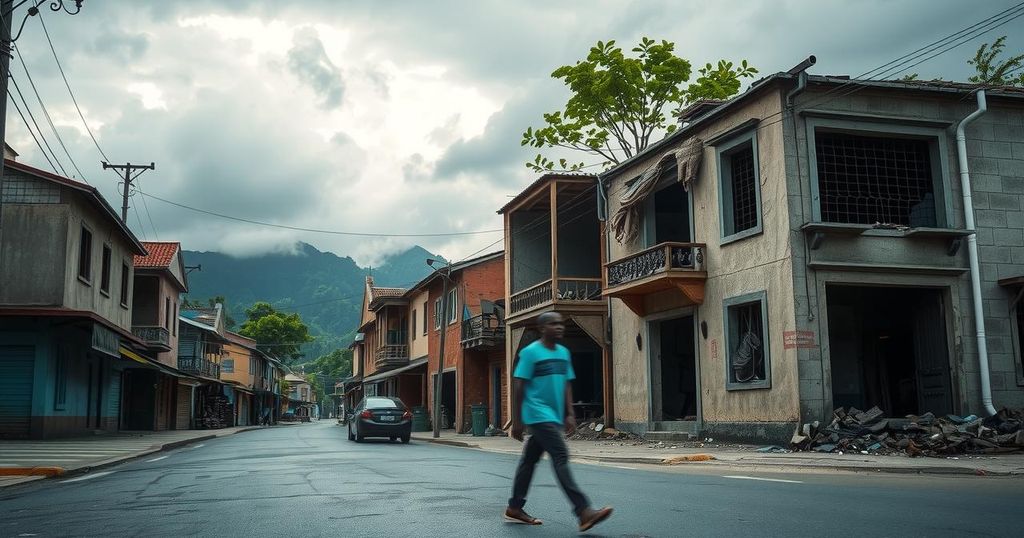The Lingering Shadows of Conflict in Goma, DR Congo
Goma, DR Congo, is experiencing ongoing turmoil after the M23 rebel group seized control three months ago. Daily life has been severely disrupted, with rising violence and humanitarian crises affecting over 1.2 million people. The city, once thriving, now faces economic collapse, crime surges, and the shadows of war loom large. With diplomatic solutions failing, residents remain trapped under the continuing conflict.
The city of Goma, situated in eastern Democratic Republic of the Congo (DRC) and once a lively border hub, is navigating an uneasy calm following a disturbing change in power. More than three months have passed since the March 23 Movement (M23) seized control in January, yet daily life for Goma’s population of over two million remains deeply affected and peace seems out of reach.
The M23’s move into Goma marked a defining moment in an ongoing conflict that has plagued the region for years. The bleak memories of similar events from 2012 still haunt residents. The fierce fighting that erupted resulted in heavy casualties, with reports indicating over 8,500 fatalities and nearly 5,600 injuries from the assault. The consequences were dire, with displacement camps also suffering attacks—eyewitness accounts have revealed the harrowing loss of pregnant women and infants caught in the crossfire.
Although the M23 declared a “humanitarian ceasefire” on February 4, many locals still face violence in North and South Kivu provinces. The group has continued to capture strategic locations—most notably the town of Bukavu, which serves as the capital of South Kivu, effectively expanding their grip in the region.
Corneille Nangaa, a prominent figure and the former electoral director, has historically expressed aspirations to “liberate the entire country, including the capital, Kinshasa.” Such ambitions signal the prospects for enduring instability, as recent reports indicate potential for prolonged conflict.
After Goma fell into M23 hands, it transitioned into a grim silence. The sound of gunfire faded, yet a new form of chaos took hold. Commercial districts, which once thrived, are now nearly abandoned, and a banking crisis has made cash almost nonexistent. Crime rates, particularly at night, have risen sharply. The absence of government has allowed the M23 to impose various checks and tariffs in the region, creating a taxing atmosphere for residents.
The humanitarian situation is bleak. The International Organization for Migration estimates that over 1.2 million individuals have fled their homes since January, with many originally finding sanctuary in Goma only to be displaced again.
In February, M23 presented a 72-hour ultimatum to evacuate major displacement camps near Goma, leading to an almost immediate exodus of families. Many departed with minimal belongings, only to discover their original villages leveled and uninhabitable.
To the west of Goma lies Sake, known as the city’s last defensive line. This area has raged in battle since late 2023, resulting in street fights that have utterly destroyed the town. Currently, threats persist, as unexploded ordnance litter the nearby banana fields. Local resident Christian Kabuya shared, “We have found live shells in over ten locations,” noting deaths from tragic accidents, especially among children.
In western Goma, Ndosho Hospital remains the only facility still operational for treating the wounded, but it’s overwhelmed. The International Committee of the Red Cross supports this crucial institution, but the pressure is intense. Taoffic Mohamed Toure, a seasoned ICRC veteran, noted, “The situation here is uniquely complex,” emphasizing the challenges posed by diverse conflict actors and ongoing violence.
As diplomatic efforts stall and ceasefires fall apart, the shadow of conflict looms over the eastern DRC. For Goma, the once-vibrant city now carries deep scars from its tumultuous history, much like the cooling lava of Mount Nyiragongo.
In summary, Goma remains trapped under the grip of the M23 rebel group, with the conflict causing immense suffering and disruption in daily life. The humanitarian situation continues to deteriorate, as displacement rises and basic institutions collapse. With analysts fearing long-term entrenchment of the conflict, the people of Goma and surrounding regions are left to navigate a precarious and dangerous existence amid the scars of war.
Original Source: english.news.cn




Post Comment